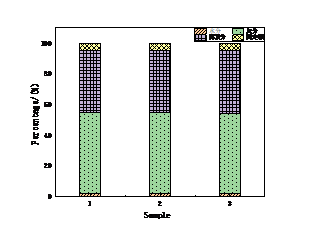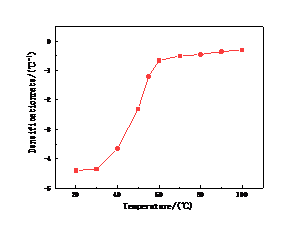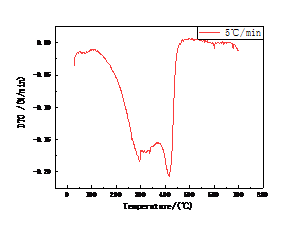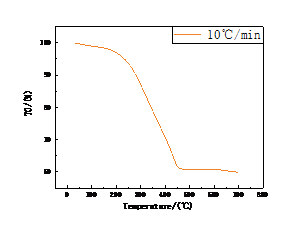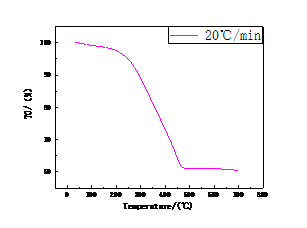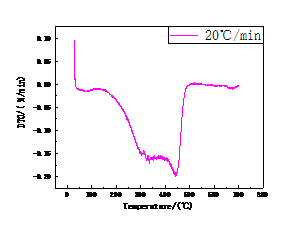费托合成蜡的热物化性质研究毕业论文
2020-04-18 20:03:00
摘 要
实验分析测定了费托合成蜡的热物化性质,采用排水法测定了密度,用显微熔点仪测定了费托蜡的熔点,量热仪测定了它的高位热值。用TG-DTG技术探究了费托蜡的热解规律,及Coats-Redfern探讨了费托蜡的热解动力学。实验结果表明:托蜡的热解分为三个阶段,第一阶段(50℃~210℃)为水分蒸发及低含碳量物质的分解,第二阶段(210℃~450℃)为烃类物质的分解,第三阶段(450℃~710℃)为中低温阶段合成的有机大分子物质的分解。随着升温速率的上升,有明显的往高温方向偏移的现象。采用Coats-Redfern计算出的热解活化能在不同的升温速率下均随着反应级数的增大而增大,在各升温速率下,反应级数n=0.8时,热解参数的拟合优度最好,而且此时活化能和指前因子存在动力学补偿效应。
关键词:费托合成 费托合成蜡 物化性质 热重 动力学
Study on thermal physicochemical properties of Fischer-Tropsch wax
Abstract
The thermal and physical properties of Fischer-Tropsch synthesis wax were determined experimentally.The density was determined by drainage method. the melting point of Fischer-Tropsch wax was determined by microscopic melting point instrument method, and the high calorific value of the specimen was determined by calorimeter. The pyrolysis law of Fischer-Tropsch wax was investigated by TG-DTG technique, and the pyrolysis kinetics of Fischer-Tropsch wax was discussed by Coats-Redfern. The experimental results show that the pyrolysis of Fischer-Tropsch wax was divided into three stages, the first stage (50℃~210℃) is water evaporation and decomposition of low carbon content, the second stage (210℃~450℃) is hydrocarbon decomposition, and the third stage (450℃~710℃) is the decomposition of organic macromolecular substances synthesized in the middle and low temperature stage. With the increase of heating rate, there will be obvious thermal lag phenomenon. The pyrolysis activation energy calculated by Coats-Redfern increasing with the increase of the reaction order at different heating rates. When the reaction order is 0.8,the goodness-of-fit of pyrolysis parameters is the best at each heating rate. Moreovre,the activation energy and the pre-exponential factor have kinetic compensation effects.
Key Words: Fischer-Tropsch synthesis; Fischer-Tropsch wax; Physical and chemical properties; Thermogravimetry; kinetics
目 录
摘要 I
Abstract II
第一章 绪论 1
1.1 费托合成技术简介 1
1.1.1 费托合成技术发展 1
1.1.2 费托合成工艺及现状 1
1.2 费托合成技术的发展前景 2
1.3 费托合成蜡的热物化性及应用 3
1.3.1 费托合成蜡的热物化性 3
1.3.2 费托合成蜡的应用 3
1.4 费托合成蜡的热分析方法 4
1.4.1 量热仪测热值 4
1.4.2 热重分析法 4
1.4.3 显微熔点仪测熔点 4
1.5 研究目的及内容 5
1.5.1 研究目的 5
1.5.2 研究内容 5
第二章 实验 6
2.1 实验原料与设备 6
2.2 实验原理 6
2.3 实验方案 7
2.3.1 热物理性质分析 7
2.3.2 热化学性质分析 7
2.4 费托蜡的预处理 7
2.5 费托蜡的工业分析 7
2.6 实验步骤 10
2.6.1 费托蜡的密度测定 10
2.6.2 费托蜡的熔点测定 10
2.6.3 费托蜡的热值测定 10
2.6.4 费托蜡的热重分析 11
第三章 实验结果 12
3.1 工业分析数据讨论 12
3.2 费托合成蜡的密度数据分析 13
3.3 费托合成蜡的热值数据分析 13
3.4 费托合成蜡的熔点数据分析 14
3.5 费托合成蜡的热解特性分析 14
3.6 费托合成蜡的热解动力学分析 18
第四章 总结与展望 21
参考文献 23
致谢 25
第一章 绪论
1.1 费托合成技术简介
1.1.1 费托合成技术的发展
费托合成技术完全实现工业化是在1936年,在此之后费托合成技术的发展跌宕起伏。自1990年以来,费托合成工艺和催化剂都得到了巨大的突破,为F-T蜡的生产准备了较为充足的材料。相比之下,费托合成蜡和石油蜡产品具有十分显著的差别,因此对于它们的使用不能相提并论[1]。
当今世界原油劣质化、重质化的趋势愈加严重,高品质轻质油品,化工原料的市场需求与日俱增,F-T合成反应独特之处就在于可以使用合成气制备燃料[2],因此它成为了如今解决能源问题的关键切入点。F-T蜡的成分主要包含C7~C120 的直链烷烃,其具备无氮、硫、芳烃等杂质的特点,是制备清洁材料、能源的理想材料。
以上是毕业论文大纲或资料介绍,该课题完整毕业论文、开题报告、任务书、程序设计、图纸设计等资料请添加微信获取,微信号:bysjorg。
相关图片展示:
